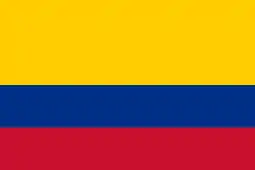Emigration from Colombia
Emigration from Colombia is a migratory phenomenon that started in the early 20th century.
Overview
Emigration from Colombia was determined mostly by security issues linked mainly to the Colombian armed conflict. From 1980-2000, emigration from Colombia was one of the largest in volume in Hispanic America. According to the 2005 Colombian census or DANE, about 3,331,107 Colombian citizens currently permanently reside outside of Colombia.[1][2] Other estimates, however, suggest that the actual number could exceed 4 million, or almost 10 percent of the country's population.[3] Approximately 1.2 million Colombians are believed to have left the country during 2000–5 and not returned.[3]
In 2005, the population movement towards North America and Europe in particular has been motivated in some cases by the threat of violence but more typically by the search for greater economic opportunity.[3] Due to the current sociopolitical situation in Colombia, emigration affects Colombians of all social standings and geographic zones. The highest rates of emigration have been registered in the main urban centers of the interior zone of the country: Bogotá, Medellín, Cali, Bucaramanga, Pereira, Manizales, and Cúcuta.
Destinations
Until 2002, external migration was primarily to the United States, Venezuela, Spain and Ecuador.[4] As of 2003, the estimated Colombian population in those countries was 2,020,000, 1,340,000, 240,000, and 193,000, respectively.[4] Panama, Italy, the Netherlands, Germany and the United Kingdom also have significant (>20,000) populations of Colombian emigrants.[4] In 2003, North America was the destination for 48 percent of Colombian emigrants; Hispanic America and the Caribbean, 40 percent; Europe, 11 percent; and Asia, Oceania, and Africa, 1 percent.[3]
The Colombian diaspora refers to the mass movement of Colombian people who emigrated from the country in search of safety and/or a better quality of life. Many of those who moved were educated middle and upper middle-class Colombians; because of this, the Colombian diaspora can be referred to as a brain drain. Colombian officials state that this movement peaked in the year 2000 and that the most popular destinations for emigration include North America and Europe. In Europe, Spain has the largest Colombian community on the continent, followed by Italy and the United Kingdom. Many Colombians are also dispersed throughout the rest of Hispanic America. Mexico, Costa Rica, Peru and Chile received political refugees in the mid-to-late 20th century, and Colombian guest workers in the early 2000s. The Colombian diaspora can also refer to the large wave of Colombian artists who migrated seeking better opportunities and new, more lucrative markets.
Colombian restaurants and bakeries are important institutions for the Colombian diaspora. These eateries have popularized formerly regional dishes like the well-portioned Bandeja paisa among Colombians from all parts of the country.
Top Colombian diaspora populations
Regions with significant populations
| Country | Population | Rank | Population [5] | Rank | Notes |
|---|---|---|---|---|---|
| 1,081,838[6] | 1 | 753,847 | 2 | For further information see Colombian Americans | |
| 721,791[7] | 2 | 988,483 | 1 | ||
| 513,583[8] | 3 | 350,802 | 3 | Largest community outside the Americas. See Colombians in Spain | |
| 146,582 [9] | 4 | 24,427 | 9 | ||
| 96,325[10] | 5 | 70,405 | 5 | For further information see Colombian Canadians | |
| 41,885 [11] | 6 | 57,051 | 6 | ||
| 77,426 [12] | 7 | 200,539 | 4 | ||
| 46,000 [13] | 8 | ||||
| 40,000 [14] | 9 | 40,000[14] | 8 | ||
| 13,922 | 10 | 20,658 | 13 | For further information see Colombian Mexicans | |
| 13,876 | 11 | 8,963 | 18 | ||
| 100,000[15][16] | 12 | ||||
| 13,411[17] | 13 | 13,411 | 12 | Second largest Latin American community after Chileans. | |
| 12,331[18] | 14 | 22,703 | 10 | Second largest South American community after Brazilians. See Colombians in the United Kingdom | |
| 11,500 | 15 | 21,400 | 12 | ||
| 11,318[19] | 16 | 16,247 | 14 | For further information see Colombian Australians | |
| 3,127[20] | 17 | 2,693 | 25 | ||
| 18 | 15,455 | 15 | |||
| 12,394 | 16 | ||||
| 8,395 | 19 | ||||
| 6,131 | 20 | ||||
| 6,086 | 21 | ||||
| 3,750 | 22 | ||||
| 3,687 | 23 | ||||
| 3,085 | 24 | ||||
| 2,548 | 26 | ||||
| 2,471[21] | 27 | ||||
| 1,758 | 28 | ||||
| 1,728 | 29 | ||||
| 1,629 | 30 | ||||
| 1,286 | 31 | ||||
| 1,228 | 32 | ||||
| 1,202 | 33 | ||||
| 979 | 34 | ||||
| 876 | 35 | ||||
| 655 | 36 | ||||
| 580 | 37 | ||||
| 456 | 38 | ||||
| 391 | 39 | ||||
| 238 | 40 | ||||
| 206 | 41 | ||||
| 201 | 42 | ||||
| 191 | 43 | ||||
| 165 | 44 | ||||
| 146 | 45 | ||||
| 133 | 46 | ||||
| 128 | 47 | ||||
| 128 | 48 | ||||
| 110 | 49 | ||||
| 56 | 50 | ||||
| 54 | 51 | ||||
| 54 | 52 | ||||
| 49 | 53 | ||||
| 43 | 54 | ||||
| 43 | 55 | ||||
| 24 | 56 | ||||
| 24[22] | 57 | ||||
| 10 | 58 | ||||
| 6 | 59 | ||||
Social and economic impact
Colombians living abroad—1.5 million of whom departed during the economic downturn between 1996 and 2002—have had a positive effect on the balance of payments thanks to remittances to family and friends at home.[3] According to Colombian newspaper El Tiempo, the value of remittances from Colombians living abroad is ranked third as the main source of foreign money in Colombia and has already surpassed the value of coffee exports.
But external migration to the United States or Europe has represented a definite loss of talent and energy because migrants to the developed world tend to be better educated and in the prime of working life.[3] Some estimates would have roughly half the physicians trained in Colombia during certain years, at great expense to fellow Colombian taxpayers, now working in the United States.[3] Then, too, there are communities (as in Mexico, for example) that have been so drained of young workers that they find themselves dependent on the flow of remittances.[3] Several municipalities in the vicinity of Pereira in western Colombia, hard hit by troubles in the coffee industry and the competition of cheap Asian labor in garment exporting, exemplify the latter phenomenon.[3]
Human trafficking
The Colombian government has developed prevention programs against illegal groups that offer emigration help to unsuspecting people, many of whom are eventually forced into slavery, forced prostitution and human trafficking in foreign countries.
See also
References
- "Yahoo forma parte de la familia de marcas de Yahoo". Yahoo forma parte de la familia de marcas de Yahoo (in Spanish). 2007-09-17. Retrieved 2021-11-05.
- "Departamento Administrativo Nacional de Estadística (DANE)". www.dane.gov.co.
- Bushnell, David and Rex A. Hudson. "Emigration". In Colombia: A Country Study (Rex A. Hudson, ed.), pp. 98-99. Library of Congress Federal Research Division (2010).
 This article incorporates text from this source, which is in the public domain.
This article incorporates text from this source, which is in the public domain. - "Migration Information Source". migrationpolicy.org. Retrieved 2021-11-05.
- "Colombia - Emigrantes totales 2017". datosmacro.com (in Spanish). Retrieved 2019-05-19.
- The Hispanic Population: 2010 U.S. Census Bureau
- INE (2011). "Población nacida en el exterior, por año llegada a Venezuela, según pais de nacimiento, Censo 2011" (PDF). Ine.gob.ve (in Spanish).
- Población (españoles/extranjeros) por País de Nacimiento, sexo y año Instituto Nacional de Estadística
- Los extranjeros en Chile suman 1.251.225 personas y en su mayoría son venezolanos, peruanos, haitianos y colombianos, theclinic.cl, 10 April 2019
- Statistics Canada (2016). "Data tables, 2016 Census – Immigration and ethnocultural diversity". 12.statcan.gc.ca.
- "Cuadro 7: Población nacida en el extranjero en la República, por grupos de edad, según sexo y país de nacimiento. INEC Panamá".
- Refugiados, Alto Comisionado de las Naciones Unidas para los. "ACNUR - Página no encontrada". UNHCR.
- "Bevölkerung in Privathaushalten nach Migrationshintergrund im weiteren Sinn nach ausgewählten Geburtsstaaten". Statistisches Bundesamt (in German). Retrieved 2022-01-21.
- "Immigrant and Emigrant Populations by Country of Origin and Destination". migrationpolicy.org. February 10, 2014.
- "La communauté colombienne en France". lepetitjournal.com. Retrieved 2017-07-17.
- Collazos, Anne Gincel (January 2010). "LOS COLOMBIANOS EN FRANCIA: UNA MIGRACIÓN PENDULARIA DEL "ENTRE DOS"". Análisis Político (in Spanish). 23 (68): 62–78. Retrieved 10 June 2020.
- "Utrikes födda efter födelseland, kön och år". www.scb.se. Statistiska Centralbyrån. Retrieved 2 March 2022.
- "Country of Birth Database" (XLS). Oecd.org. Retrieved 2017-08-10.
- Department of Social Services (2011). "The Colombia-born Community". Archived from the original on 2017-09-24. Retrieved 2017-12-10.
- IMMIGRANTS(1), BY PERIOD OF IMMIGRATION, COUNTRY OF BIRTH AND LAST COUNTRY OF RESIDENCE Archived 2013-10-15 at the Wayback Machine Statistical Abstract of Israel 2008
- 在留外国人統計(旧登録外国人統計)統計表 法務省
- https://www.pmlp.gov.lv/lv/media/8190/download
